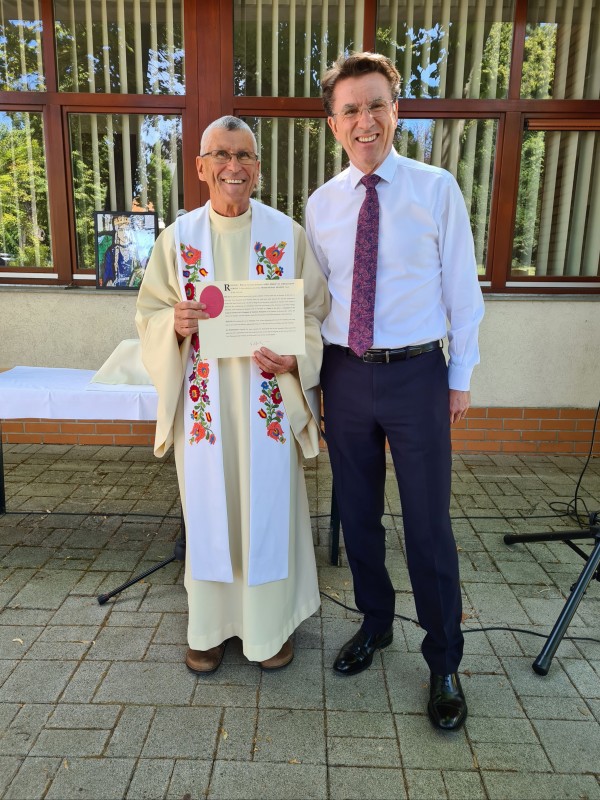Anglicanism in Hungary
The Rev. Dr. Frank Hegedűs was re-licensed in early August as Chaplain at Saint Margaret’s, Budapest. In this article, he tells us about Anglicanism in Hungary, which celebrates Saint Stephen’s Day on 20 August.
I was relicensed as Chaplain at Saint Margaret's, Budapest, on Sunday, 2 August. I am of Hungarian ancestry, came to the Diocese as Chaplain in 2011 from the US Episcopal Diocese of Los Angeles and currently also serve as Area Dean in Central Europe.
British Ambassador to Hungary, H.E. Mr Iain Lindsay (pictured), a friend of Saint Margaret's, attended the ceremony along with his wife Bridget and administered the oath of office. The Saint Margaret's community, like so many of our Diocese's congregations, is international in make-up, with members coming from the UK, Hungary, Africa, North America, and elsewhere.

The service was held outdoors on the beautiful grounds of the Protestáns Szakkollégium, a residence hall for Lutheran and Reformed Church university students located in the hills above Budapest.
I have been invited to write about Christian faith in Hungary and the place of Anglicanism within it. Hungary is predominantly Roman Catholic but with significant minorities of Reformed/Presbyterian, Lutheran, Orthodox, and Baptist, among others. Perhaps uniquely in the European Union, the Hungarian State recognises some thirty official, or established, churches, of which Saint Margaret's and the Anglican Communion is one. This gives the Church stature in Hungarian society as well as access to the Hungarian Church Tax Scheme, through which taxpayers, at their discretion, may give 1% of their tax duty to the Church at no additional cost to themselves. This has been immensely beneficial to Saint Margaret's.
Anglicans are attested in Hungary as far back as the late nineteenth century, mostly business-people and, interestingly, English equestrians engaged by the nobility at the time. Worship remained a bit sporadic during Communist rule with a cleric coming to Budapest periodically from Vienna. Our current Saint Margaret's community was founded in 1992 by the Rev. Canon Denis Moss. He and his wife, Maria, continue to live in Hungary in retirement near Lake Balaton. About one-third of our current community is British, and another third, Hungarian. We have a number of members from the nations of Africa and from North America as well.
Saint Stephen and Hungary
There is an annual ecumenical service held on the eve, or vigil, of Saint Stephen’s Day, which in Hungary is celebrated on 20 August. This is typically well attended by leaders of the Churches, often including Cardinal Péter Erdő who is Cardinal of the Latin Rite of the Catholic Church, the Archbishop of Esztergom-Budapest, and Primate of Hungary. Government ministers also usually attend. Bishop David represented the Anglican Communion at this event some years ago. Sadly, in current circumstances, I was not present this year.
The origin of the Hungarian peoples is still debated among scholars. During the great migrations of peoples following the collapse of the Roman Empire, the Hungarian tribes eventually made their way from Central Asia to the Carpathian Basin, settling there over the course of the tenth century. To this day, they retain their unique Magyar language, only distantly related to Finnish, Estonian, and Sami. However, Hungarian is not mutually intelligible with any other language.
Saint Stephen, an early tribal leader and king, established the Hungarian State at the end of the tenth century, having been made king in the year 1000, according to legend with a crown provided by the pope. The crown is still on display in the iconic Hungarian Parliament building along the Danube. Saint Margaret of Scotland, of the pre-Norman English royal family, our patronal saint, is reputed to have been born in exile in an ancient castle at Mecseknádasd in southern Hungary.
Stephen is universally considered to have been a good king, and Hungary flourished at various times during the Middle Ages. Over the centuries, however, it has been invaded, and sometimes devastated, by Mongols, Turks, Austrians, Germans, and Russians. Some see this somewhat tortured history as an explanation of a perceived wariness of outsiders among some Hungarians. Personally, I am not so sure. Hungarians are a pretty friendly bunch.
Hungary Today
Today, Hungary is an integral part of the European Union with a population of just under ten million. In many ways, it is still emerging from the decades under Communism following World War II. Roughly a third of the populace lives in or near Budapest, a vibrant commercial and logistics hub for Central Europe. The countryside is renowned for its unique central flatlands and farms, called in Hungarian the Alföld or Puszta. As is common in much of Central Europe, society here is considerably more conservative in customs and politics than in most of Western Europe. In the popular mind, Hungary remains perhaps best known for Budapest, its beautiful capital and an architectural gem; its notoriously difficult language; and its spicy cuisine and fruity wines.
In terms of the current challenges of Covid-19, Hungary reacted early and quickly to the pandemic and, after weeks of strict quarantine, now has emerged with relatively few cases.
I feel very blessed to be Chaplain in this wonderful city and to be a part of the Diocese in Europe. Given that I am well into my seventies, I can honestly say that in my case God has certainly saved the best for last.
**
Köszönöm szépen (thank you very much!) to Fr. Frank for this article.
You can find out more about the life of Saint Margaret’s Anglican & Episcopal Church on their website.


